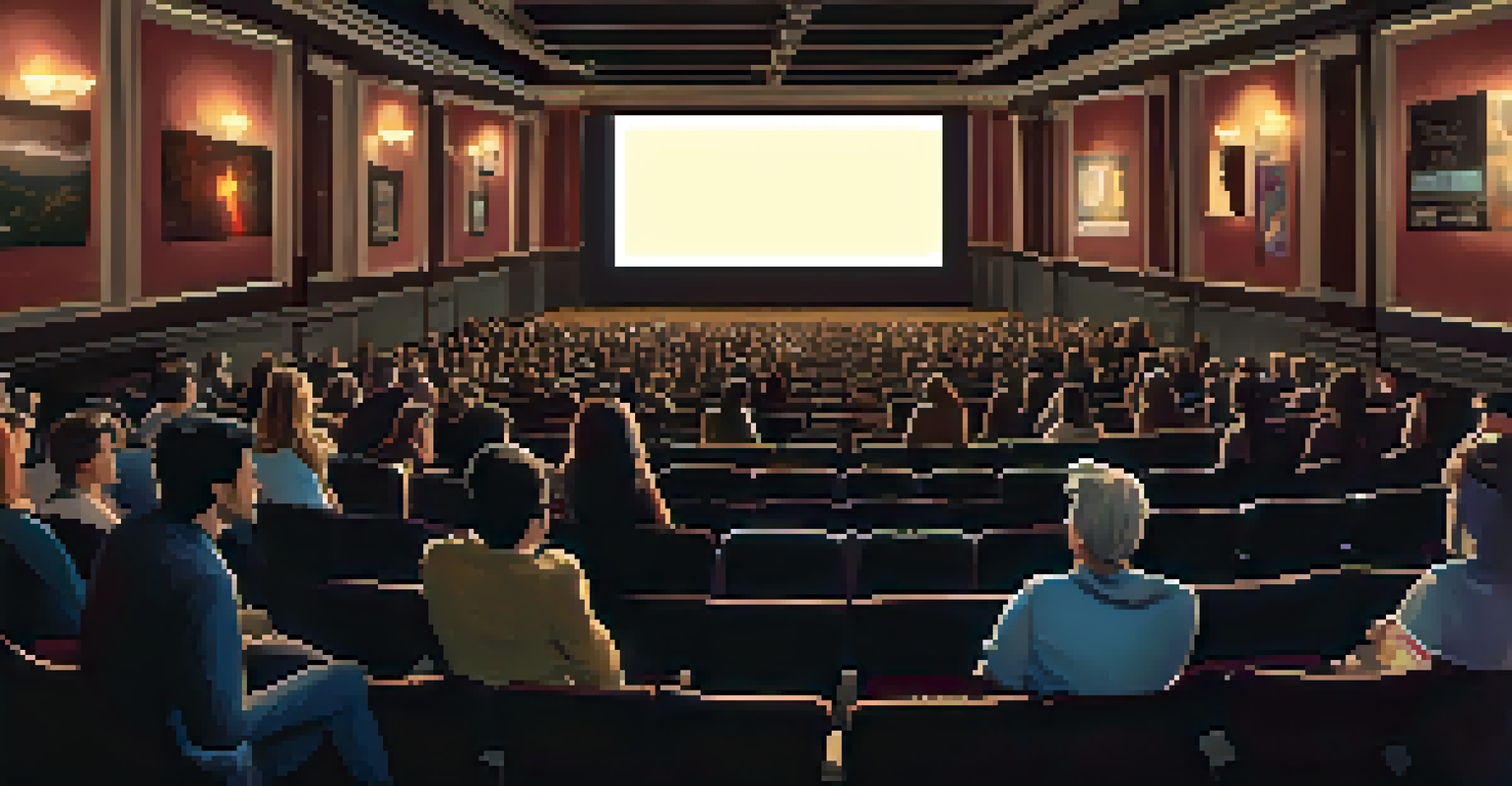The Financial Crisis: Effects on Hollywood Budgets and Films

Understanding the Financial Crisis and Its Origins
The financial crisis of 2007-2008 was a significant global economic downturn, primarily triggered by the collapse of the housing market in the United States. It led to widespread bank failures and plunging stock markets, affecting various industries worldwide. Hollywood, often viewed as a resilient industry, was not immune to these financial tremors, as the crisis forced studios to reevaluate their spending habits and project viability.
The only thing worse than a bad movie is a movie that doesn’t make any money.
As the crisis deepened, consumer confidence plummeted, leading to reduced discretionary spending. This shift meant that people were more cautious about spending money on entertainment, directly impacting box office revenues. With fewer people flocking to theaters, studios faced the harsh reality of dwindling profits, prompting a reevaluation of how much they could afford to spend on films.
Understanding this economic backdrop is crucial to grasping how Hollywood responded to the crisis. The industry's reaction would not only change how films were financed but also influence the types of stories being told, as studios sought to adapt to a new, more financially cautious audience.
The Immediate Effects on Film Budgets
In the wake of the financial crisis, Hollywood studios faced an urgent need to cut costs. Many projects that had previously received greenlights were suddenly shelved or drastically altered, with budgets slashed to keep production afloat. This shift was evident in the shift away from big-budget blockbusters towards more modestly priced films that could still attract audiences without the same financial risks.

For instance, movies that traditionally had budgets exceeding $100 million began to dwindle in number. Studios turned to strategies such as co-financing and international partnerships to spread financial risk and ensure profitability. This meant that filmmakers had to work within tighter constraints, often leading to more innovative storytelling and creative solutions.
Financial Crisis Reshaped Hollywood
The 2007-2008 financial crisis forced Hollywood to adapt its spending and storytelling to meet the challenges of a more cautious audience.
While some filmmakers thrived under these new conditions, others found it challenging to adapt. The pressure to produce quality content on a smaller budget often led to a surge in independent films, as well as a resurgence of creative narratives that resonated with audiences looking for relatable stories amid economic uncertainty.
Shifts in Film Genres and Themes
As Hollywood grappled with tighter budgets, the types of films being produced began to reflect the challenges of the time. Audiences were drawn to stories that mirrored their own struggles, leading to a rise in films that focused on realism and relatable themes. Movies that tackled issues such as economic hardship, family dynamics, and resilience found their footing in this new landscape.
In the midst of chaos, there is also opportunity.
For example, films like 'The Big Short' and 'Moneyball' not only entertained but also educated viewers about the financial crisis and its consequences. These narratives allowed audiences to connect with the material on a more personal level, as they saw their own experiences reflected on screen. This shift highlighted a growing preference for substance over spectacle during tough economic times.
Moreover, the crisis ignited a trend toward socially conscious filmmaking. More filmmakers began to explore themes surrounding inequality, community struggles, and personal triumphs, enriching the cinematic landscape with diverse stories that resonated deeply with viewers. This cultural shift marked a significant departure from the escapist fare that had previously dominated the box office.
The Rise of Independent Filmmaking
With major studios tightening their purse strings, independent filmmakers found themselves in a prime position to step into the spotlight. These creators often embraced smaller budgets, allowing for greater artistic freedom and experimentation. As a result, independent films began to garner more attention and acclaim, often outperforming mainstream productions in terms of creativity and storytelling.
The financial crisis inadvertently led to a flourishing of indie cinema, as audiences became more receptive to unique and unconventional narratives. Films like 'Precious' and 'The Hurt Locker' not only captured critical acclaim but also proved that compelling storytelling could thrive outside the big studio system. This shift encouraged a new generation of filmmakers to pursue their visions, despite financial constraints.
Rise of Independent Filmmaking
As studios cut back on budgets, independent filmmakers gained prominence, producing unique stories that resonated with audiences.
Additionally, the rise of digital distribution platforms like Vimeo and online film festivals provided independent filmmakers with avenues to reach audiences directly. This democratization of film distribution meant that stories could be told without the backing of major studios, allowing for a richer tapestry of voices and perspectives in the industry.
Impact on Marketing Strategies for Films
As Hollywood adjusted to the realities of a financial crisis, marketing strategies underwent a significant transformation. Studios began focusing on cost-effective marketing tactics that could maximize visibility without breaking the bank. This included leveraging social media platforms and grassroots campaigns to engage audiences directly, rather than relying solely on traditional advertising methods.
For instance, films like 'Paranormal Activity' utilized viral marketing campaigns that created buzz at a fraction of the cost of conventional marketing. By engaging with potential viewers through unconventional channels, these films captured the zeitgeist and drew audiences into theaters. This shift in marketing strategy not only saved costs but also fostered a more intimate connection between filmmakers and their audiences.
Moreover, the emphasis on digital marketing allowed for more targeted approaches, enabling studios to reach specific demographics more effectively. This data-driven strategy meant that films could be marketed to the audiences most likely to enjoy them, optimizing both reach and impact. Thus, marketing became a critical component in navigating the financial landscape of the post-crisis Hollywood.
The Influence of International Markets
As domestic box office revenues dwindled, Hollywood studios began to look towards international markets as a source of revenue. This shift was particularly significant during the financial crisis when studios realized that global audiences could help cushion the blow of declining local ticket sales. Consequently, films were increasingly tailored to appeal to international tastes, often incorporating diverse cast members and themes.
For example, blockbusters like 'Transformers' and 'Fast & Furious' series saw a substantial portion of their box office earnings come from international markets. This trend prompted studios to invest in films that could resonate with global audiences, leading to a more inclusive approach to filmmaking. The recognition of international markets as a vital revenue stream reshaped the kinds of stories being told and how they were presented.
Shift to Global Markets
Hollywood increasingly relied on international markets for revenue, leading to films tailored for global audiences and diverse narratives.
Furthermore, the rise of international co-productions allowed studios to pool resources and share risks. This collaborative approach not only diversified the types of films being produced but also brought fresh perspectives to Hollywood storytelling. By embracing a global mindset, Hollywood positioned itself to thrive even in the face of economic uncertainty.
Long-Term Changes in Hollywood's Approach
The financial crisis left an indelible mark on Hollywood's approach to filmmaking and budgeting. While the immediate effects were challenging, they also led to a more nuanced understanding of audience preferences and financial sustainability. Studios emerged with a greater appreciation for the value of storytelling that resonates with everyday experiences, paving the way for a more diverse array of films.
In the years that followed, Hollywood continued to embrace the lessons learned during the crisis. The emphasis on independent filmmaking, international collaboration, and innovative marketing strategies became integral to the industry's evolution. As a result, the landscape of Hollywood transformed, offering audiences a richer and more varied cinematic experience.

Ultimately, the financial crisis served as a catalyst for change, prompting Hollywood to adapt in ways that would not only ensure survival but also enhance creativity. The industry emerged stronger and more resilient, proving that even in the face of adversity, storytelling has the power to connect, inspire, and entertain.